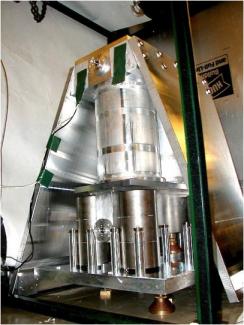Of all the fundamental forces, gravity is the most difficult to precisely measure. This difficulty is reflected in how hard it is to accurately measure “Big G,” a fundamental constant that is part of the measurement of the gravitational force. In fact, big G is the least precisely measured fundamental constant in physics. Who would have imagined that the very first fundamental force to be discovered would still be somewhat mysterious more than 300 years later? Or, that a force most of us take for granted in everyday life is actually very hard to precisely measure?
Fellow Jim Faller and his colleague Harold Parks of Sandia National Laboratories in Albuquerque, New Mexico know first hand about the difficulties of making precision measurements of big G. The two physicists completed a measurement of big G in 2004, but their measurement was so much smaller than the currently accepted value (by about 10 standard deviations) that they spent another six years trying to figure out what they’d done wrong. When they couldn’t figure out anything wrong with what they’d done, they published their measurements in September of 2010.
With that, Faller has grown philosophical. “I feel like I’ve checked everything, and I have to wash my hands,” he said, noting that for centuries physicists have been trying to improve on Henry Cavendish’s initial measurement of big G in 1797. And, even though modern measurements, including Faller’s and Parks’, all claim accuracies of a few tens of parts per million, there’s a lot more variation between the measurements than scientists expected to see.
In 2000, Jens Gundlach and Stephen Merkowitz of the University of Washington in Seattle came up with the most precise measurement of big G in history. As an added bonus, the uncertainty of this measurement was relatively low. Soon afterward, another group reported measurements that agreed with this measurement. It seemed that the precision measurement of big G had taken a big step forward.
Fast forward a decade, and two groups report smaller values for big G: Faller and Parks (10 standard deviations lower) and a group from China whose value for big G is about 3 standard deviations lower than the widely accepted 2000 value. In response to the new measurements, the Committee on Data for Science and Technology (CO-DATA) will likely revise down the value of G in its next set of values to be finalized in 2011 and, at the same time, increase the uncertainty associated with its value.
The more pressing issue, according to Faller, is: Who’s right? Knowing that most metrologists around the world already thought that Gundlach’s and Merkowitz’s value for big G was correct made Faller’s and Parks’ experiment a lot harder.
“We looked under every rock we could to find systematic errors that we might have overlooked, but we found nothing.” Consequently, Faller and Parks decided to publish their results and let the chips fall where they would. So far, their new paper has been a newsworthy item in physics circles. Bloggers have started to weigh in on whose value for big G is correct.
Even so, the controversy over big G begs also another question: What good will be accomplished with ever-more precise measurements of big G since physics, at least today, doesn’t need a better number?
Faller’s knows the answer to this question: “Big G is the Mt. Everest of precision measurement science, and it should be climbed.” - Julie Phillips




